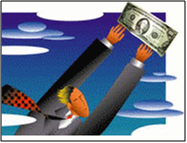However, there are a number of different ways to motivate and engage your employees. The two most common methods are reward and recognition. While often used interchangeably, they are really two different practices—each with its own benefits. Find out more about which ones to leverage and how to dramatically impact the success of your innovation initiatives.
Rewards
For internal-facing challenges, financial rewards can become problematic considering logistics of global application and the ability to sustain motivation overtime.
Some issues include:
Alternatively, nonfinancial and nonmaterial rewards can effectively motivate your employees while incentivizing being part of a larger team and collaborating for the improvement of the company as a whole.
Nonfinancial rewards can be:
By thinking outside the box and creatively tapping the spirit of co-creation and collaboration, non-financial rewards can have a positive impact on sustaining participation from employees in a variety of different internal innovation campaigns.
Recognition Recognizing employees for their contributions can provide much more than just a psychological benefit. Management consultant and author Cindy Ventrice states that, as long as employees have what is considered a fair wage, “money is not really a factor in how motivated they are.” Instead, it comes down to feeling valued in the workplace, that their thoughts and opinions matter, and that there is opportunity for learning and advancement.
Managers can recognize employees in a variety of ways:
While these are all virtually without cost, they are essential to building trust between employees and managers, and can encourage your employees to achieve more and continue to think outside the box.
Streamline and Automate Recognition Engaging and recognizing employees on multiple fronts can seem like a daunting task. However, software solutions (such as Brightidea) can help you manage your recognition plans by creating a single platform for both employee collaboration and recognition from management. These solutions integrate recognition systems with features such as:
With dynamic user profiles and analytics on all system activity, innovation management software such as Brightidea’s Innovation Suite can also help you keep track and compare user activity and give you real-time statistics about top contributors and the impact on the company from concept to cash overtime.
Recognition in the Innovation Community
Business innovation author Steven Johnson claims that this environment is “where good ideas come from.” Outlying and disruptive ideas often come from these “liquid networks,” where information is freely traded.
Employees also want to be acknowledged for their ideas. But it is also crucial to acknowledge the efforts of contributors. The support players who contribute and help develop an idea are essential to the ideation process, and should be recognized with their own feedback and praise. In recognizing along the entire innovation lifecycle, and closing the loop of communication from initial idea collection through implementation, you increase the likelihood of garnering participation in future campaigns.
Finally, rewards and recognition are not mutually exclusive. Together, they can jumpstart your workplace by getting people excited and making meaningful contributions. However, while rewards can help keep your workers motivated, it’s recognition that builds a truly innovative culture. In the end, it’s showing your employees that their contributions are seen by their managers, respected, and valued that will have the most positive impact on your business and bring real results for your innovation initiatives. |
Recent Blog Entries
Employee Spotlight: Ge... (0 comment)
Employee Spotlight: Ge... (0 comment)
Employee Spotlight: Me... (0 comment)
Employee Spotlight: Br... (0 comment)
Employee Spotlight: Me... (0 comment)
Active Blogs
Brightidea’s API & GE’... (6 comments)
SPOTLIGHT OF THE MONTH... (2 comments)
Employee Spotlight: Me... (2 comments)
Brightidea Employee Sp... (1 comment)
Employee Spotlight Ser... (1 comment)
Blog Archives
Terms and Conditions | Contact Us: service@brightidea.com |
 Generating workplace engagement is difficult. Business thinker
Generating workplace engagement is difficult. Business thinker  Rewards—both financial and non-financial—can play an important part in an innovation initiative. However, at Brightidea we recommend that financial or material rewards be reserved primarily for public campaigns, where incentives are necessary to attract attention and drive large-scale participation from external parties. For example, GE’s
Rewards—both financial and non-financial—can play an important part in an innovation initiative. However, at Brightidea we recommend that financial or material rewards be reserved primarily for public campaigns, where incentives are necessary to attract attention and drive large-scale participation from external parties. For example, GE’s  There are several practices to take into consideration when approaching employee recognition. Some of the most important practices are:
There are several practices to take into consideration when approaching employee recognition. Some of the most important practices are: Recognition is a crucial component to a building a sustained and thriving innovation community. First, encouraging greater communication and transparency builds trust between employees and managers. In this environment, employees can contribute ideas without the fear of being “wrong.” leading to a freer flow of thoughts and ideas.
Recognition is a crucial component to a building a sustained and thriving innovation community. First, encouraging greater communication and transparency builds trust between employees and managers. In this environment, employees can contribute ideas without the fear of being “wrong.” leading to a freer flow of thoughts and ideas.


